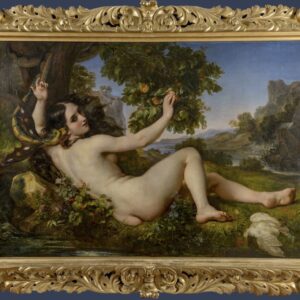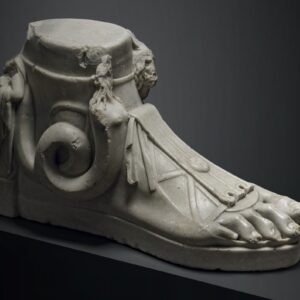The Uffizi Galleries is comprised of two museums and a public garden. The Uffizi itself is in a building designed by Vasari in 1560 for Cosimo I de’ Medici to accommodate the “offices” of Florence’s magistrates; the Palazzo Pitti, originally constructed for Luca Pitti but purchased in 1549 by the Medici who turned it into their main residence across the River Arno; and the Palazzo’s splendid 16th-century gardens known as “Boboli” after the original owners of their land. With over 4 million visitors a year, it’s the most popular museum complex in Italy. Since 2015 German-born Eike Schmidt

has been its first foreign director. Indeed, thanks to his love of Italy, Mr. Schmidt is so committed to the Uffizi, that he turned down the offer to head the Kunsthistorisches Museum in Vienna. Last week during an hour-long interview with members of the Stampa Estera he described the Uffizi during Covid-19 and his plans for the future. Here’s a synthesis.
The Uffizi complex has been closed since March 8, but that doesn’t mean nothing is going on. The security squad continues their in-house surveillance to protect the artworks from theft and to monitor the climate control. During the first week of closure the two museums were sanitized. There’s no need to worry about chemical damage to the paintings as they’re all protected by special state-of-the-art non-reflective glass.
The administration and all its curators are working from home keeping careful daily records of their activities and holding weekly meetings via the internet. No one has lost his or her job. Their projects include digitalization of administrative records and of the museums’ artworks and future temporary exhibition planning.
In addition, starting on March 10 the Uffizi, Palazzo Pitti, and the Boboli Gardens have changed from being a conventional museum conglomerate to a virtual one by setting up video virtual tours— added daily on its Facebook account–of its many collections and individual artworks in Italian (many with English subtitles) by Schmidt or various curators. The only exception is a tour in Spanish of its Spanish paintings. There are plans to add virtual tours in several languages and not just of the museums, but of the Boboli Gardens too. These virtual tours are free-of-charge and will remain so, Facebook’s followers having increased by 50,000 since March 8. In the last week the Uffizi activated a live virtual tour on the museums’ site. With just a click, it’s possible to walk through ten perfectly digitalized halls of the Gallery. Maybe in the future the Uffizi could consider charging for special programs on-line or special events in situ after re-opening. But, for now, charging for digital contents would be against the Uffizi’s founder’s principles. For in 1737 Anna Maria Luisa de’ Medici, the last Medici heiress, via the avant-garde agreement known as Patto di Famiglia donated the family’s art collections to the city of Florence for public use, education, and tourism. In 1765 they were officially opened to the public, formally becoming a national museum in 1865. Hence the Uffizi belongs to the people of Italy.

As for temporary exhibitions three are ready to open. Already mounted in Palazzo Pitti is The Greatness of the Universe in the Art of Giovanna Garzoni. Garzoni (1600-1670), prominent during the Baroque period, started her career painting religious, mythological, and allegorical subjects, but became famous for her botanical works in tempera and watercolors. She worked at several European royal courts, but her primary patrons were the Medici. Thus, a section here will reconstruct Vittoria Della Rovere’s (wife of Ferdinando II de’ Medici) Wunderkammer. Ready but still to be mounted, also in the Palazzo Pitti, is Stories of Painted Pages. Medieval Manuscripts and Illuminations Recovered by the Carabinieri’s Florentine Cultural Heritage Protection Unit. Soon to be mounted in the Uffizi building is the first monographic exhibition ever devoted to the Florentine, Giuseppe Bezzuoli (1789-1855), a protagonist of 19th-century painting. The sculptures of Horatio Greenough and Hiram Powers and landscape paintings by Thomas Cole will be displayed in a special section devoted to young American artists who attended Bezzuoli’s courses at Florence’s Accademia di Belle Arti. In recent years the Uffizi has bought five of his paintings.

Other temporary exhibits still in the planning stages but scheduled to open during the second half of 2020 have been postponed to open exactly one year from their original opening date. Also worth mentioning is that the already well-attended Ai Piedi Degli Dei or At Gods’ Feet in the Palazzo Pitti’s Museum of Costume and Fashion will reopen. This is an exhibition of the history of shoes and sandals– from ancient sculptures to those worn by Liz Taylor in “Cleopatra”, Charlton Heston in “Ben-Hur”, and Russell Crowe in “The Gladiator”.
Speaking of protagonist painters, Schmidt assured us that he was working to prolong the exhibition “Raffaello” until at least December 31, and even longer if necessary, and that, as the major loaner, the Uffizi would leave all its loans in place with most other museums following their example. For this mega-show is unrepeatable and is thus an important contribution for Italy’s cultural, touristic, and therefore economic recovery.
When it comes to economic recovery, “the Uffizi has “broad shoulders” or “sufficient economic resources” to sustain closure for two or three months. Schmidt estimated that March’s closure has cost the Uffizi some 10 million euros in lost entrance fees in these two months. The Uffizi, like “Raffaello,” is gradually reimbursing their unlucky on-line ticket purchasers. However, if closure lasts longer, the Uffizi will have to modify its budget radically. This means postponing its architectural and layout modernizations. Schmidt pointed out that because of its huge number of visitors, the Uffizi is luckier than many smaller and less visited museums in Florence. Luckily, in 2018, it had been agreed that all State museums would donate 20% of their proceeds to smaller, less visited museums. At that time, the Uffizi also instituted a 3-day ticket the included the Opificio delle pietre dure (“Workshop of Semi-Precious Stones”), a kind of Applied Arts Museum most famous for its restoration schools and library, as well as Florence’s National Museum of Archeology, which houses the world’s most important collection of Etruscan art and Italy’s second-most important ancient Egyptian collection after Turin’s.
Also, before Covid-19 the Uffizi had introduced on-line ticket purchasing so as to avoid the long lines. When the Ministry of Culture decides that it’s safe to re-open, the Uffizi will open the same day as all other Italian National Museums and all of them will follow the same safety criteria. Only then will the Uffizi start re-selling tickets online.
Schmidt isn’t worried about fewer visitors. A virtual tour can never replace a real-life one. “It’s the same for sports events or movies,” he explained. “Watching a game on TV is not the same emotionally as going to the stadium. Nor did movies kill live theater.” However, Schmidt doesn’t expect a deluge of visitors during 2020. He speculates that the visitors will be Florentines and Italian nationals. Hopefully, the foreign visitors will be able to return in 2021 and it’s at that time that Schmidt thinks there will be a huge increase in visitors, just as there was after the 1966 flood (an increase of more than 1.5 million visitors) and the 1993 bomb.
Since 2018, in addition to the “common ticket” that includes admission to the Uffizi conglomerate, the Opificio, and the Archeology Museum, Schmidt introduced multiple-visit and annual tickets. He’s also working, in collaboration with the University of L’Aquila, to perfect the on-line ticket purchase with specific entry time and length of stay so that the longer the stay, the cheaper the ticket. His aim is to discourage the “selfie and run” visitors, those who only want to memorialize themselves in front of Botticelli’s “Birth of Venus” or “Spring” and reward those who want a “Renaissance” experience. His dream is a “Slow Museum”. Schmidt also pointed out that, while most famous for its Italian Renaissance paintings, the Uffizi houses art from all over the world, in particular Islamic countries, sub-Saharan Africa, and China, many works having been diplomatic gifts to the Medici, important collections of ancient Greek and Roman sculpture, Spanish paintings and drawings, and except for the Hermitage, the largest collection of Dutch and Flemish paintings outside the Low Countries.












